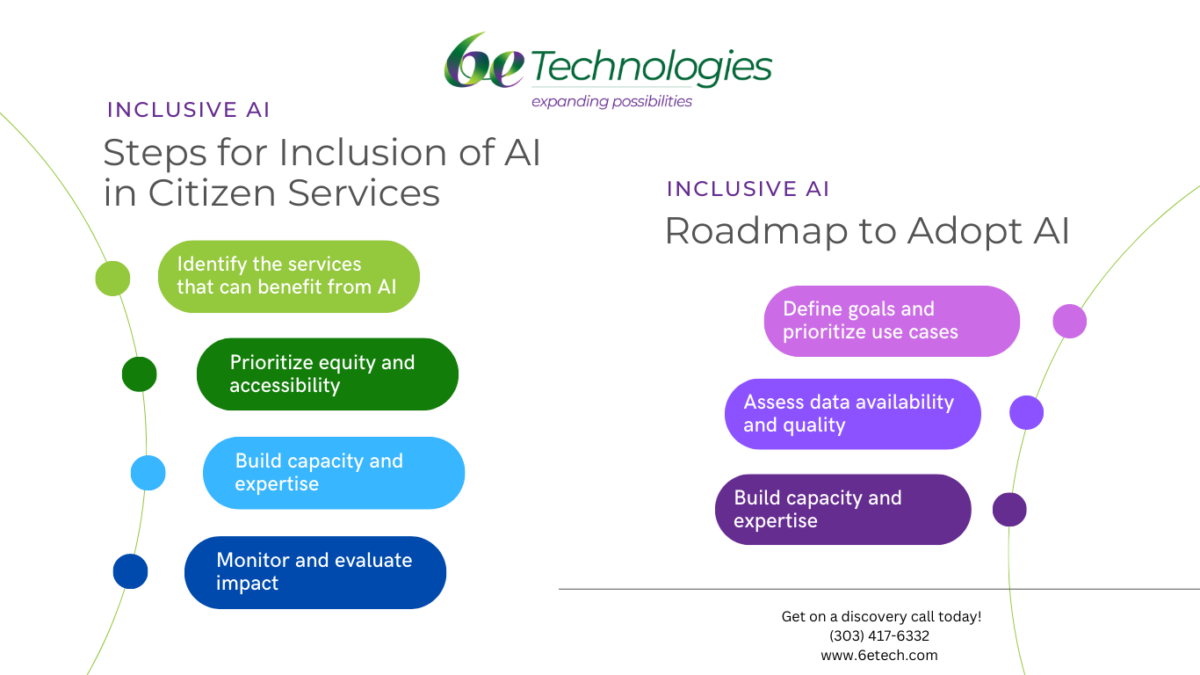As technology continues to rapidly advance, the public sector is exploring how to integrate artificial intelligence (AI) into its services to improve efficiency, effectiveness, and accessibility. However, to truly leverage the potential of AI, the public sector must ensure that its implementation is inclusive and does not exacerbate existing inequalities.
Here are some steps that the public sector can take to plan for the inclusion of AI in citizen services:
- Identify the services that can benefit from AI: The public sector should first identify the services that can be improved through the use of AI, such as healthcare, education, transportation, and social services. For example, AI can be used to personalize healthcare recommendations based on a patient’s medical history, predict traffic congestion and optimize transportation routes, and provide tailored learning experiences for students.
- Prioritize equity and accessibility: In planning for AI implementation, the public sector must prioritize equity and accessibility to ensure that the benefits of AI are not limited to a select few. This can be achieved by involving diverse stakeholders, including citizens and community organizations, in the design and implementation process, and ensuring that AI systems are developed with a focus on reducing bias and discrimination.
- Build capacity and expertise: The public sector should invest in building the necessary capacity and expertise to design, develop, and implement AI systems. This can be achieved through partnerships with universities, private sector organizations, and research institutions. Additionally, the public sector should prioritize training and education programs to equip its workforce with the necessary skills to effectively leverage AI in citizen services.
- Monitor and evaluate impact: To ensure that AI implementation is inclusive and effective, the public sector should continuously monitor and evaluate its impact on citizens and communities. This can be achieved through data collection and analysis, citizen feedback mechanisms, and regular performance assessments.
Example: One example of the public sector using AI to improve citizen services is the City of Amsterdam’s AI-driven traffic management system. The system uses real-time data from cameras and sensors to predict traffic congestion and optimize traffic flow, reducing travel times and improving air quality. The City also prioritized equity and accessibility in its implementation, by involving citizens and community organizations in the design process and ensuring that the system does not discriminate against any particular group.
Here is a roadmap that the public sector can use to adopt AI in an inclusive and effective manner:
- Define goals and prioritize use cases: The first step in adopting AI in the public sector is to define clear goals and prioritize use cases. This includes identifying areas where AI can improve citizen services and setting measurable objectives for AI adoption.
- Assess data availability and quality: AI systems require large amounts of data to function effectively. The public sector should assess the availability and quality of data to ensure that it is suitable for AI applications. This includes evaluating data sources, assessing data quality, and addressing any data gaps or limitations.
- Build capacity and expertise: To effectively adopt AI, the public sector needs to build capacity and expertise in AI development and deployment. This includes investing in training and education programs, developing partnerships with private sector organizations and research institutions, and hiring AI experts and data scientists.
- Develop ethical and legal frameworks: As AI adoption increases, the public sector must develop ethical and legal frameworks to guide its use. This includes developing guidelines for responsible AI development, ensuring privacy and security of citizen data, and addressing issues of bias and discrimination.
- Pilot and scale AI initiatives: The public sector should pilot AI initiatives in a controlled environment to test their effectiveness and gather feedback from citizens and stakeholders. Successful pilots can then be scaled up to a wider audience.
- Monitor and evaluate impact: It is important to continuously monitor and evaluate the impact of AI on citizen services to ensure that it is delivering the intended benefits. This includes collecting and analyzing data, gathering feedback from citizens and stakeholders, and regularly assessing AI performance.
By following this roadmap, the public sector can adopt AI in an inclusive and responsible manner, ensuring that it delivers maximum benefits to citizens and communities while minimizing any potential risks.
In conclusion, the adoption of AI by the public sector has the potential to greatly improve citizen services, but it must be done in an inclusive and responsible manner. To ensure that AI implementation is inclusive, the public sector must prioritize equity and accessibility, involve diverse stakeholders in the design and implementation process, and focus on reducing bias and discrimination. It is also important to build capacity and expertise in AI development and deployment, develop ethical and legal frameworks, pilot and scale AI initiatives, and continuously monitor and evaluate the impact of AI on citizen services. By following these steps, the public sector can harness the power of AI to improve citizen services and create a more equitable and just society.



